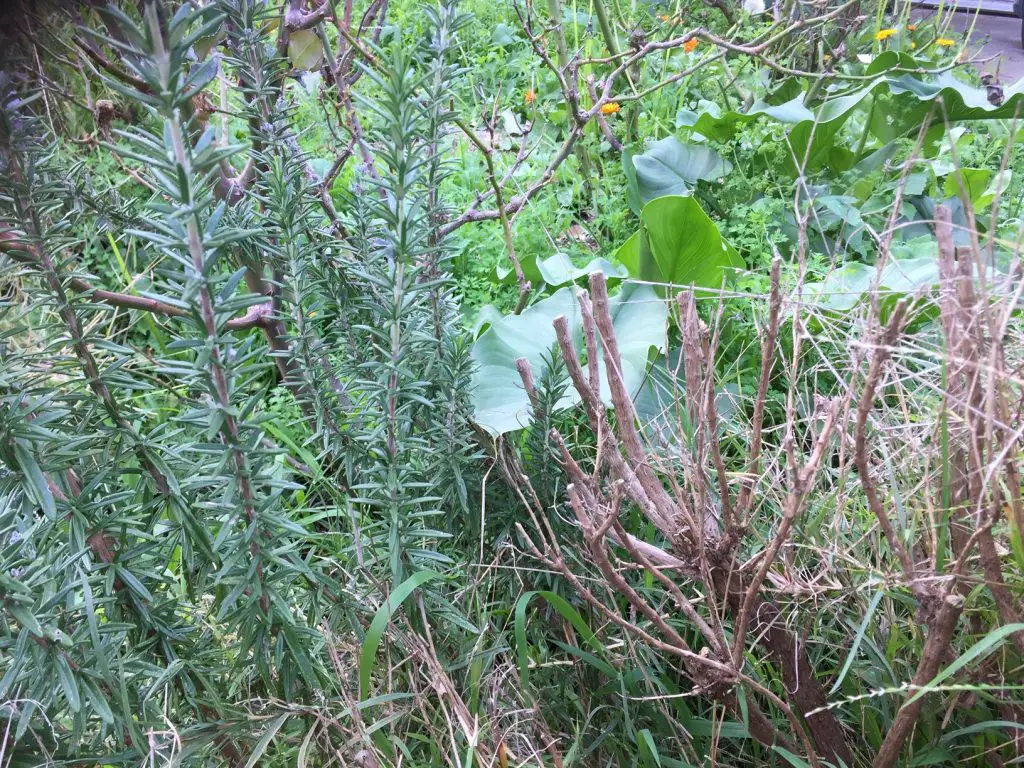Can Rosemary Be Cut Right Back? Rosemary is a popular herb that many people have in their gardens which is a very low maintenance plant that is highly tolerant of dry conditions. However, it can get a little leggy after a while and does require the occasional prune to keep things in check. But in cases where the plant has not been trimmed for a long time how hard can you cut the rosemary back, is ok to cut it right back to the ground?
It is generally not a good idea to cut Rosemary to the ground as pruning the shrub too hard can result in the plant dying. Rosemary does not respond well to pruning when cuts are made into the hardwood below the point at which new growth can be seen. If this is done there is a chance the plant may not survive.
An example of this can be seen in my own garden at home where I cut a section of my rosemary plant too hard and it resulted in a section of the plant not growing back. In the photograph below you can see a section on the right-hand side of the photograph that was cut too hard a season or two ago that has not regenerated.

However, if you have a really old rosemary bush that is not looking good because it has a heap of deadwood in the plant, it has become leggy and is generally more of an eyesore rather than an asset you may consider trying cutting it to the ground.
In this case, the plant will either reshoot allowing it to be reshaped or it will die and need to be replaced. Either way, your garden will be better off. But in my experience, there is a pretty good chance the plant will die.
How To Prune A Rosemary Bush
To avoid the situation described above it is best to prune the plant once or twice a year to ensure that you are able to maintain an attractive shape without risking the creation of dead spots within the plant.
When Is The Best Time To Prune Rosemary?
Rosemary is fairly forgiving when it comes to the timing of the pruning. Rosemary can be pruned anytime during Spring or Summer. In Autumn the shrub can also be pruned but it is not advisable to do this within a month of the first frost. The reason for this is that pruning will encourage the creation of new growth that is relatively tender and more susceptible to frost damage.
Tips On Pruning Rosemary Bushes
Tip 1 – Use Clean Sharp Secateurs Or Pruning Shears
The first consideration when pruning a plant is the secateurs you are using. To avoid the potential for problems it is advisable to ensure that they are clean and sharp. Blunt secateurs or pruning shears can crush the branches rather than cut them cleanly. Ragged uneven cuts take longer to heal which leaves the rosemary vulnerable to attack from bacteria or pests.
To clean the blade it is best to use a rag and an organic solvent, such as acetone or methylated spirits as this removes any plant residue that is on the blade.
Tip 2 – Visualise The Desired Shape Of The Bush
Before you even start cutting it is advisable that you try to visualize the shape that you want. This is particularly important in cases where the plant needs drastic reshaping. Often in these cases, it will necessary to do the reshaping in multiple stages to ensure that not too much of the plant is removed at any one time.
If more than a quarter of the branches needs to removed you need to allow at season between successive trims a provide the plant with the chance to recover.

Tip 3 – Remove Any Dead Or Diseased Wood
To ensure the ongoing health of the plant it is important to remove any broken branches and deadwood. This is important as this can provide an entry point for pests and diseases.
Tip 4 – Cut Above Any New Grow
To avoid dead spots within your plant it is important to always cut above the point where you can see new growth. This is important to ensure that an individual plant branch does not die back in a similar to what is seen in the image at the start of the article.
When choosing the location where the cut will be made it is important to ensure that the growth is strong and at least a couple of inches long. Trimming above spindly growth that only has a few leaves has the potential to cause dieback.
Tip 5 – Make The Plant Bushier By Trimming Regularly
To increase the foliage coverage in a rosemary plant it is advisable to trim the plant regularly. I would recommend trimming the plant at the start of spring and the end of summer. The regular trimming will result in the plant becoming bushier over time because each cut made encourages the plant to produce multiple new shoots. This is also a useful technique that can help fill dead spots in the plant over time.
In cases where the plant is already has a good shape, it is only necessary to trim off an inch or two. The easiest way to do this is to cut the plant in late spring when the new growth is still soft using a hedge trimmer. This particularly suitable if you are creating a hedge from the rosemary.
